
Woodworking is the skill of making items from wood, and includes cabinetry, furniture making, wood carving, joinery, carpentry, and woodturning.

Lumber is wood that has been processed into uniform and useful sizes, including beams and planks or boards. Lumber is mainly used for construction framing, as well as finishing. Lumber has many uses beyond home building. Lumber is referred to as timber in the United Kingdom, Europe, Australia, and New Zealand, while in other parts of the world the term timber refers specifically to unprocessed wood fiber, such as cut logs or standing trees that have yet to be cut.
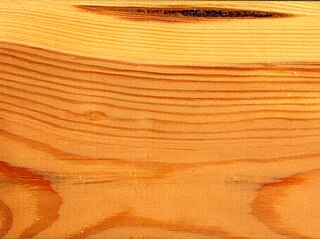
Softwood is wood from gymnosperm trees such as conifers. The term is opposed to hardwood, which is the wood from angiosperm trees. The main differences between hardwoods and softwoods is that the structure of hardwoods lack resin canals, whereas softwoods lack pores.
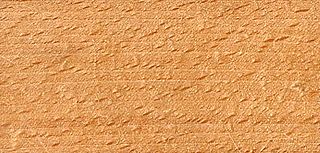
Hardwood is wood from dicot trees. These are usually found in broad-leaved temperate and tropical forests. In temperate and boreal latitudes they are mostly deciduous, but in tropics and subtropics mostly evergreen. Hardwood contrasts with softwood.
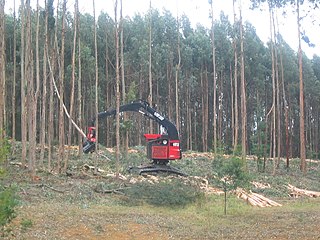
Pulpwood can be defined as timber that is ground and processed into a fibrous pulp. It is a versatile natural resource commonly used for paper-making but also made into low-grade wood and used for chips, energy, pellets, and engineered products.

Woodchipping is the act and industry of chipping wood for pulp. Timber is converted to woodchips and sold, primarily, for paper manufacture. In Australia, woodchips are produced by clearcutting or thinning of native forests or plantations. In other parts of the world, forestry practices such as short rotation coppice are the usual methods adopted.

Wood anatomy is a scientific sub-area of wood science, which examines the variations in xylem anatomical characteristics across trees, shrubs, and herbaceous species to explore inquiries related to plant function, growth, and the environment.
Lee Ann Newsom is an Associate Professor of Anthropology at the Pennsylvania State University at University Park. She has written numerous books and articles. She was awarded a MacArthur Fellowship in 2002.
Paleontology or palaeontology is the study of prehistoric life forms on Earth through the examination of plant and animal fossils. This includes the study of body fossils, tracks (ichnites), burrows, cast-off parts, fossilised feces (coprolites), palynomorphs and chemical residues. Because humans have encountered fossils for millennia, paleontology has a long history both before and after becoming formalized as a science. This article records significant discoveries and events related to paleontology that occurred or were published in the year 1954.

A wood-burning stove is a heating or cooking appliance capable of burning wood fuel, often called solid fuel, and wood-derived biomass fuel, such as sawdust bricks. Generally the appliance consists of a solid metal closed firebox, often lined by fire brick, and one or more air controls. The first wood-burning stove was patented in Strasbourg in 1557. This was two centuries before the Industrial Revolution, so iron was still prohibitively expensive. The first wood-burning stoves were high-end consumer items and only gradually became used widely.
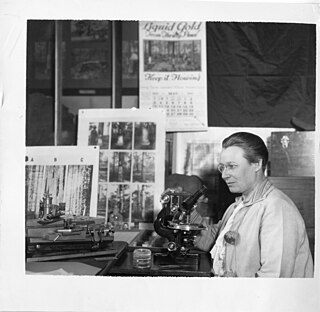
Eloise Gerry was an influential research scientist whose early 20th century work contributed greatly to the study of southern pine trees and turpentine production. Gerry was the first woman appointed to the professional staff of the U.S. Forest Service at the Forest Products Laboratory, and one of the first women in the United States to specialize in forest products research.

Wood science is the scientific field which predominantly studies and investigates elements associated with the formation, the physical and chemical composition, and the macro- and microstructure of wood as a bio-based and lignocellulosic material. Wood science additionally delves into the biological, chemical, physical, and mechanical properties and characteristics of wood as a natural material.
The International Association of Wood Anatomists (IAWA) is an association that studies wood anatomy formed in 1931. Their office is currently based in the Netherlands.

Pieter Baas was a Dutch botanist and an emeritus professor of plant systematics at the Leiden University, who served as director of the Rijksherbarium of Leiden University between 1991 and 1999. When the institute was faced with budget cuts in 1993 he managed to preserve the collection by joining it with the university collections of Wageningen and Utrecht. This led to the founding of the National Herbarium of the Netherlands in 1999. Baas subsequently became director of the institute and served until 2005. As a botanist, Baas specialised in wood anatomy, and was an elected fellow of the International Academy of Wood Science.

Alberta Maria Wilhelmina "Bep" Mennega was a Dutch botanist renowned for her studies into the anatomy of wood and plant systematics. The standard author abbreviation Mennega is used to indicate this person as the author when citing a botanical name.
Fritz Hans Schweingruber was a Swiss dendrochronologist and emeritus professor.

Xanthophyllum lanceatum is a tree in the Polygalaceae family. It grows across Southeast Asia from Sumatera to Bangladesh. The leaves are used as a hops-substitute in beer making and the wood as fuel. Fish in the Mekong regularly eat the fruit, flowers and leaves.
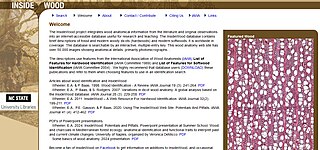
InsideWood is an online resource and database for wood anatomy, serving as a reference, research, and teaching tool. Wood anatomy is a sub-area within the discipline of wood science. This freely accessible database is purely scientific and noncommercial. It was actually created by several international researchers, members of the IAWA, mostly botanists, biologists and wood scientists.

Peter Niemz (1950) is a German-born Swiss materials engineer, retired wood scientist and emeritus professor of the Institute of Building Materials at ETH Zurich, who is an elected fellow (FIAWS) of the International Academy of Wood Science.

Gerald Koch is a German wood scientist and professor, senior researcher and research scientific director at the Thünen-Institute of Wood Research at Hamburg, who is an elected fellow of the International Academy of Wood Science.
















